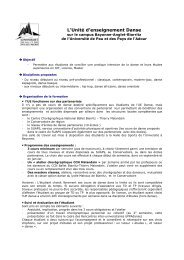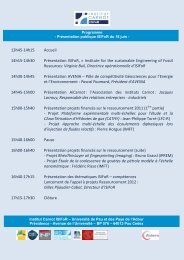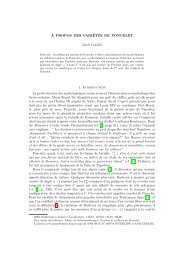Detection of Best Practices in the Field of University Entrepreneurship
Detection of Best Practices in the Field of University Entrepreneurship
Detection of Best Practices in the Field of University Entrepreneurship
You also want an ePaper? Increase the reach of your titles
YUMPU automatically turns print PDFs into web optimized ePapers that Google loves.
BEST PRACTICES DETECTED<br />
The follow<strong>in</strong>g list does follow any order that may signal our op<strong>in</strong>ion on <strong>the</strong> importance<br />
<strong>of</strong> one best practice over ano<strong>the</strong>r. It is completely random and we have made no effort<br />
<strong>in</strong> classify<strong>in</strong>g <strong>the</strong>m.<br />
1. Utilize your immediate environment resources (extend your practice fur<strong>the</strong>r with<br />
coord<strong>in</strong>ated collaboration with o<strong>the</strong>r organizations related to sp<strong>in</strong>-<strong>of</strong>f promotion.<br />
It is also cost effective)<br />
2. Secure a source <strong>of</strong> Entrepreneurs (most researchers are not entrepreneurs.<br />
Fur<strong>the</strong>rmore, <strong>the</strong> entrepreneur pr<strong>of</strong>ile is <strong>in</strong> general scarce. Locate a reliable<br />
source <strong>of</strong> entrepreneurs such as bus<strong>in</strong>ess schools or create your own<br />
entrepreneurs through an entrepreneurship studies program)<br />
3. Understand that new venture creation is about implementation (This is a handson<br />
bus<strong>in</strong>ess. It’s about proactivity. It demands good project management skills.<br />
The best plan is useless without a good implementation.)<br />
4. The essential build<strong>in</strong>g blocks <strong>of</strong> a sp<strong>in</strong>-<strong>of</strong>f (Team, Knowledge and Capital / All<br />
new companies need <strong>the</strong>m and new venture creation can be viewed as match<strong>in</strong>g<br />
or acquisition process <strong>of</strong> a few essential elements. In a way, support staff should<br />
act as “brokers” for <strong>the</strong>se elements)<br />
5. Avoid loos<strong>in</strong>g <strong>the</strong> few valuable opportunities (communicate <strong>the</strong> importance <strong>of</strong><br />
NOT publish<strong>in</strong>g before address<strong>in</strong>g <strong>the</strong> TTO. Also, make sure research l<strong>in</strong>es and<br />
projects are not redundant or obsolete, tak<strong>in</strong>g <strong>in</strong>to account what is be<strong>in</strong>g done<br />
outside <strong>of</strong> your <strong>in</strong>stitution)<br />
6. Run <strong>the</strong> entrepreneurship center like a bus<strong>in</strong>ess (Chalmers: “we are a company<br />
factory”. Do so <strong>in</strong>dependently <strong>of</strong> hav<strong>in</strong>g considerable economic support)<br />
7. Layout your process (understand and communicate what researchers should<br />
know, expect and do chronologically)<br />
8. Deliver what you claim (are you really provid<strong>in</strong>g <strong>the</strong> quality services that you<br />
claim? In some cases, <strong>the</strong>re may be more market<strong>in</strong>g than substance)<br />
9. Build critical mass (be less str<strong>in</strong>gent at <strong>the</strong> beg<strong>in</strong>n<strong>in</strong>g if necessary. Also, at <strong>the</strong><br />
beg<strong>in</strong>n<strong>in</strong>g your capacity to manage projects is questionable. Consider a consortia<br />
<strong>of</strong> universities or reach<strong>in</strong>g agreements with o<strong>the</strong>r external research organizations<br />
like hospitals to reach a m<strong>in</strong>imum number <strong>of</strong> yearly disclosures. 70-100 are<br />
approximately needed to guarantee 3-4 new sp<strong>in</strong>-<strong>of</strong>fs per year)<br />
10. Market yourself (communicat<strong>in</strong>g results is important)<br />
11. Focus on comparative advantages and historical expertise <strong>of</strong> your environment<br />
12. Cut your losses short (like any <strong>in</strong>vestment, reevaluate <strong>in</strong>volvement at different<br />
stages. Ask yourself if you would aga<strong>in</strong> <strong>in</strong>vest know<strong>in</strong>g what you know now.<br />
Have a filter evaluation on a regular basis to move each project to a major next<br />
step)<br />
13. F<strong>in</strong>d <strong>the</strong> right product-market comb<strong>in</strong>ation (<strong>the</strong>se two elements are <strong>in</strong>separable;<br />
an opportunity is only real if you have both a superior applicable technology and<br />
a market for it.)<br />
14. Provide standard and personalized services (some processes are simple, common<br />
and can be standardized, some cannot / same can be said about <strong>the</strong> <strong>in</strong>formation<br />
entrepreneurs need)<br />
15. Utilize <strong>in</strong>dustry jo<strong>in</strong>t-ventures (it dim<strong>in</strong>ishes risks, adds credibility and provides<br />
a distribution channel <strong>in</strong>to <strong>the</strong> marketplace)
















